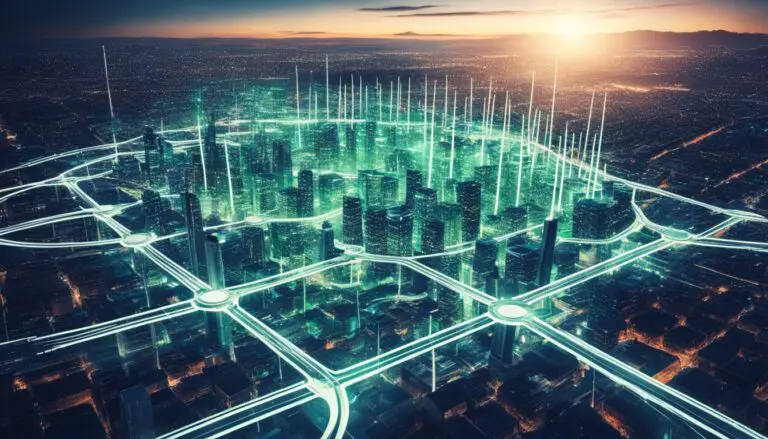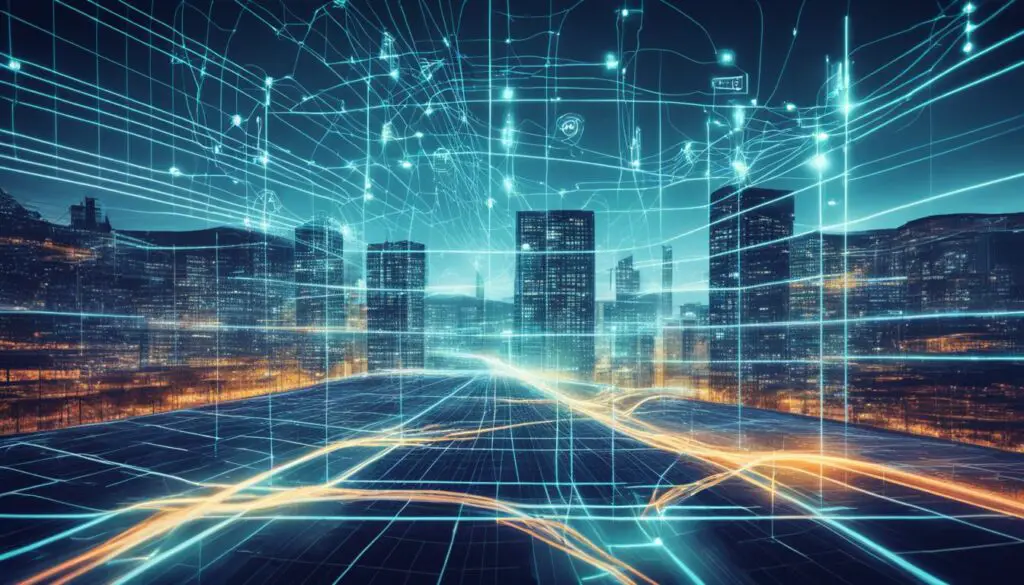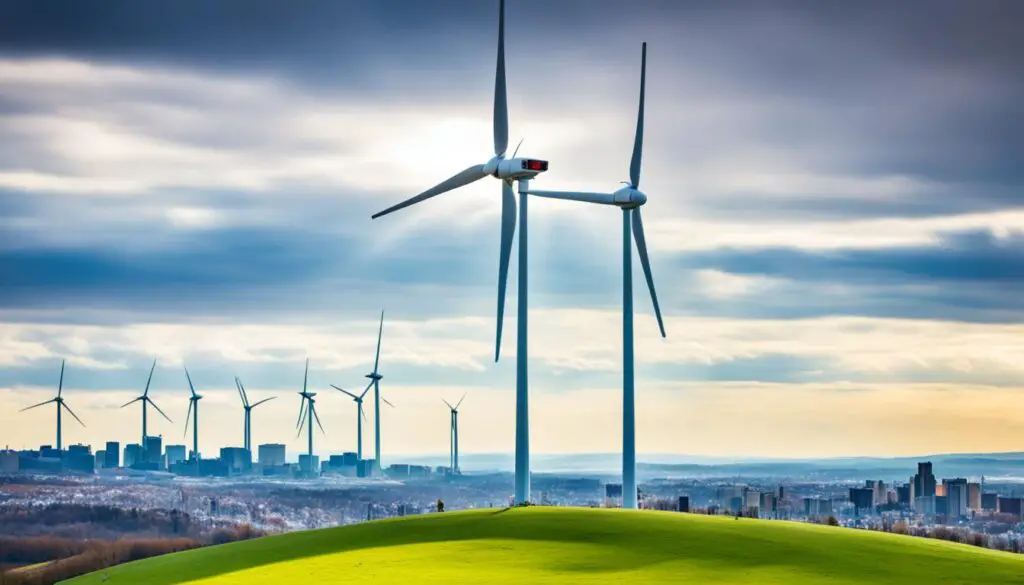The demand for electricity is growing, and so is the need for renewable energy. Smart grid technology is key to our future energy systems. It helps us work towards a sustainable, green future by making the use of electricity more efficient.
This technology uses digital tools, sensors, and software for real-time electricity management. It lets us mix in renewable energy and gives people a way to help save energy. This creates a greener, more sustainable way to use power.
Putting money into smart grids is a big step towards a Net Zero Emissions future by 2050. These grids use smart meters and other equipment to keep electricity flowing smoothly, lower costs, and keep the grid stable. This is vital for all countries, especially those developing and emerging economies during their energy shifts.
Key Takeaways:
- Smart grid technology optimizes the supply and demand of electricity, promoting sustainability in future energy systems.
- Digital technologies, sensors, and software play a vital role in enabling real-time monitoring and control of electricity distribution.
- Smart grids facilitate the integration of renewable energy sources and active consumer participation in energy efficiency.
- Investment in smart grid infrastructure is crucial for achieving a Net Zero Emissions future by 2050.
- Emerging market and developing economies should prioritize investment in smart grids to support their energy transition goals.
What are Smart Grids and Why are They Important?
Smart grids change how we get and manage electricity. They use digital tech, sensors, and software. This helps balance the supply and demand of electricity, keeping the grid stable and reliable.
Smart grids matter more as we use more electricity and add renewables like wind and solar to the grid. It’s tough to keep supply and demand balanced. Smart grids help manage the flow of electricity to meet this challenge.
Smart grids lower costs and reduce the need for new grid infrastructure. They make the grid more resilient and reliable. This lowers the chance of power outages and boosts system performance.
They also make adding renewables to the grid easier. This is key for a sustainable energy future and cutting down on fossil fuels. By managing electricity better, smart grids use renewable resources well and cut waste.
Smart grids let people take part in saving energy. With data and monitoring, we can make smart choices about using electricity. This helps us all work towards a more sustainable energy system.
Investment in smart grids needs to increase, especially in emerging market and developing economies, to achieve the Net Zero Emissions by 2050 Scenario.
Investing in smart grids helps build a better, green electricity network. It meets our changing needs. Making smart grids a priority moves us towards a greener, renewable energy-powered future.
The Benefits of Smart Grids
Here are some key benefits of smart grids:
- Enhanced grid reliability and resilience
- Optimized supply and demand of electricity
- Seamless integration of renewable energy sources
- Active consumer participation in energy efficiency
- Improved monitoring and control capabilities for swift response to power outages
- Reduced costs and need for new grid infrastructure
These benefits lead to a sustainable, future-ready electricity network. It can handle the changing energy world.
| Benefit | Description |
|---|---|
| Enhanced grid reliability and resilience | Smart grids improve grid stability and reduce the risk of power outages, ensuring reliable electricity supply. |
| Optimized supply and demand of electricity | By dynamically balancing supply and demand, smart grids minimize wasted energy and maximize efficiency. |
| Seamless integration of renewable energy sources | Smart grids enable the efficient integration of variable renewable energy sources like wind and solar into the grid. |
| Active consumer participation in energy efficiency | With real-time data and feedback, consumers can actively monitor and manage their energy consumption. |
| Improved monitoring and control capabilities | Smart grids enable rapid response to power outages and allow for proactive maintenance of the grid. |
| Reduced costs and need for new grid infrastructure | By optimizing the existing grid, smart grids minimize the need for costly infrastructure upgrades. |
Understanding Smart Grids: Evolution and Benefits
Smart grids are key in changing how we use electricity by allowing electricity to flow both ways. Unlike old grids, which only send electricity one way, smart grids can move it both to and from homes. This change makes energy management more efficient and reliable while cutting waste.
Smart grids let people and utilities talk to each other better. Thanks to smart meters, you can see how much energy you’re using as it happens. This lets people use energy smarter and supports a greener future.
Smart grids can quickly deal with power outages by spotting problems right away. They help utilities find and fix issues faster. This reduces inconvenience and saves time and money.
They also make it easier to use renewable energy like solar and wind power. As we move to cleaner energy, smart grids manage these sources well. They keep the energy supply steady, even when renewable sources aren’t constant.
To see the benefits of smart grids, consider this example:
Picture a neighborhood full of rooftop solar panels. On sunny days, these panels create extra electricity. With a smart grid, this extra power can be shared with others. This not only makes the most of renewable energy but also lightens the load on traditional power plants.
Also, smart grids make our energy system more efficient by reducing energy lost in transmission. They help save energy and reduce greenhouse gases. By finding and fixing inefficiencies, smart grids make our energy system better and cheaper.
| Benefits of Smart Grids: |
|---|
| Enhanced communication between consumers and utilities |
| Advanced monitoring and control for swift response to power outages |
| Seamless integration of renewable energy sources |
| Active consumer participation in energy efficiency efforts |
| Improved overall energy efficiency |
Conclusion
Smart grid tech is key for our future energy needs. It brings together digital tech, sensors, and software. This enhances how we use energy, making it more efficient and sustainable.
Investing in smart grid tech is essential for a zero emissions future by 2050. This is especially true for developing economies. It leads to a future that’s both greener and brighter by making energy use smarter.
Smart grid tech is changing our energy systems for the better. It tackles the rising demand for electricity and makes our energy use smarter. By adopting smart grid tech, we ensure a better future for energy. This is good for us now and for generations to come.



